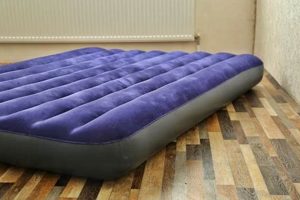The reduction of air volume within an inflatable sleeping surface, typically resulting in a loss of firmness and support, constitutes a common issue. This phenomenon can manifest through slow leaks, valve malfunctions, or punctures in the mattress material.
Maintaining consistent inflation is critical for optimal comfort and support during use. The consequences of its occurrence range from minor inconvenience to significant sleep disruption, particularly if the mattress is intended for extended use or provides support for individuals with specific health needs. Understanding the causes allows for preventative measures and timely repairs, extending the life of the product. Historically, addressing this issue has involved various patching techniques and valve designs.
Therefore, the following sections will examine common causes, methods for detection and repair, and preventative measures to minimize the likelihood of this occurrence.
Minimizing Air Loss in Inflatable Mattresses
Implementing preventative strategies and addressing potential issues promptly can significantly prolong the lifespan and maintain the performance of inflatable mattresses.
Tip 1: Choose a Durable Material. Mattresses constructed from thicker gauge PVC or reinforced fabrics are inherently more resistant to punctures and abrasion, thereby reducing the likelihood of air loss.
Tip 2: Conduct Routine Inspections. Regularly examine the mattress surface, seams, and valve for any signs of wear, damage, or potential leaks. Early detection allows for prompt intervention.
Tip 3: Protect the Mattress Surface. Utilize a mattress protector or topper to shield the inflatable surface from sharp objects, rough surfaces, and excessive friction, minimizing the risk of punctures.
Tip 4: Avoid Overinflation. Adhere strictly to the manufacturer’s recommended inflation level. Overinflation can stress the seams and valve, increasing the potential for leaks and eventual failure.
Tip 5: Store Properly When Not in Use. When not in use, deflate the mattress completely, fold it carefully, and store it in a cool, dry place away from direct sunlight and extreme temperatures. This prevents material degradation and valve damage.
Tip 6: Employ a Leak Detection Method. Periodically apply a soapy water solution to the mattress surface, seams, and valve area. The formation of bubbles indicates the presence of a leak, allowing for precise identification and targeted repair.
Tip 7: Maintain Valve Integrity. Ensure the valve is properly sealed after inflation and that the valve mechanism is free from debris or damage. A secure valve closure is critical to prevent gradual air escape.
By consistently implementing these recommendations, the incidence of air loss can be substantially reduced, resulting in enhanced product longevity and improved user satisfaction.
The subsequent sections will delve into specific repair techniques and advanced troubleshooting methods to address persistent or complex issues.
1. Puncture vulnerability
Puncture vulnerability stands as a primary cause of air mattress volume reduction. This susceptibility stems from the relatively thin and flexible materials typically used in construction. Sharp objects, uneven surfaces, or even the pressure exerted by body weight over time can create perforations, initiating a loss of internal air pressure. The extent of volume loss is directly proportional to the size and number of punctures sustained.
The presence of even a small puncture can initiate a gradual, yet persistent, decrease in mattress firmness, compromising the intended level of support. For instance, a seemingly minor tear caused by a pet’s claw or an unnoticed pebble beneath the mattress can lead to progressive sagging throughout the night. The practical significance lies in the potential for discomfort, disrupted sleep, and the eventual inability of the mattress to provide adequate support, particularly for individuals with back pain or other musculoskeletal conditions.
Therefore, understanding puncture vulnerability is crucial for implementing preventative measures such as using protective barriers and exercising caution during handling and storage. Minimizing exposure to sharp objects and ensuring proper inflation levels are essential strategies for mitigating the risk and extending the functional lifespan of the inflatable mattress, thereby maintaining its intended performance characteristics.
2. Valve malfunction
Valve malfunction represents a critical pathway for air escape in inflatable mattresses, directly contributing to the deflating process. The valve’s primary function is to provide a secure and airtight seal, preventing the egress of pressurized air. Failure to achieve this seal, whether due to physical damage, contamination, or inherent design flaws, results in a progressive loss of air volume. This loss can manifest as a slow leak, imperceptible at first, eventually leading to a noticeable reduction in firmness and support. For example, a cracked valve housing, a deformed sealing surface, or the accumulation of dust particles within the valve mechanism can all compromise its ability to maintain a tight seal.
The importance of valve integrity is amplified by the dynamic pressure exerted within the inflated mattress. As weight is applied, internal pressure increases, exacerbating any existing leakage pathways. Furthermore, repeated inflation and deflation cycles can place stress on the valve components, accelerating wear and tear. The practical significance of this understanding lies in the need for regular valve inspection and maintenance. Cleaning the valve to remove debris, ensuring a tight cap seal, and replacing damaged components are essential steps in preventing air loss. Certain mattress designs incorporate specialized valve systems with multiple seals or locking mechanisms to enhance reliability and minimize the risk of malfunction.
In conclusion, valve integrity is paramount for maintaining the inflated state of an air mattress. Addressing valve malfunctions promptly through inspection, cleaning, and component replacement is crucial. Understanding the mechanisms by which valves fail enables users to implement preventative measures and prolong the overall lifespan of the inflatable mattress, ultimately contributing to consistent comfort and support.
3. Seam separation
Seam separation represents a critical structural failure mode directly contributing to inflatable mattress air loss. The integrity of the seams, where individual material panels are joined, is paramount to maintaining the mattress’s airtight enclosure. C
ompromised seams provide a direct pathway for pressurized air to escape, initiating and accelerating the deflation process.
- Stress Concentration
Seams inherently function as points of stress concentration. During inflation and use, the material surrounding the seams is subjected to elevated tensile forces. Repetitive loading, particularly when exceeding the design limits of the seam, leads to fatigue and eventual failure. For example, a mattress subjected to frequent weight shifts or used by individuals exceeding the weight capacity may experience accelerated seam degradation.
- Manufacturing Defects
Inherent weaknesses introduced during the manufacturing process can predispose seams to premature separation. These defects may include inadequate adhesive bonding, insufficient welding strength, or improper stitching techniques. For instance, incomplete fusion during heat sealing or inconsistent thread tension during sewing can create localized weak points prone to rupture under pressure. Such defects may not be immediately apparent but manifest over time with use.
- Material Compatibility
The compatibility of the materials used in seam construction directly impacts the overall seam strength and durability. Mismatched materials, such as incompatible adhesives or dissimilar fabric weaves, can result in weakened bonds and increased susceptibility to separation. The use of inappropriate solvents during cleaning or exposure to extreme temperatures can also compromise the integrity of the bonding agents. This incompatibility undermines the long-term performance of the seam.
- Environmental Factors
Environmental factors such as humidity, ultraviolet (UV) exposure, and chemical exposure can accelerate the degradation of seam materials, contributing to separation. Prolonged exposure to direct sunlight weakens the adhesives or polymers used in seam construction. Similarly, high humidity levels can promote the growth of mold or mildew, further compromising the seam’s structural integrity. Contact with certain cleaning agents or solvents can also cause material degradation, increasing the likelihood of seam failure.
In conclusion, understanding the underlying causes of seam separation, ranging from stress concentration and manufacturing defects to material incompatibility and environmental factors, is essential for mitigating air loss. Implementing quality control measures during manufacturing, selecting appropriate materials, and adhering to proper maintenance practices are crucial for prolonging the lifespan of inflatable mattresses and maintaining their intended performance characteristics. The cumulative effect of these factors directly influences the rate and extent of air leakage observed in compromised mattresses.
4. Temperature sensitivity
Temperature sensitivity significantly influences the internal pressure of inflatable mattresses, thereby directly impacting the phenomenon of air volume reduction. Gases, including air, expand when heated and contract when cooled, following the principles of thermodynamics. Consequently, an inflatable mattress filled at a moderate temperature will exhibit reduced firmness when exposed to colder conditions, due to the decrease in air volume. Conversely, exposure to higher temperatures will increase internal pressure, potentially stressing the mattress material and seams. This effect is more pronounced in mattresses constructed from less elastic materials. For instance, a mattress inflated to optimal firmness during the day may feel noticeably softer during a cold night.
The practical significance of temperature sensitivity lies in the need for adjustments to the initial inflation level based on ambient conditions. Failing to account for temperature fluctuations can lead to either under-inflation, resulting in insufficient support, or over-inflation, increasing the risk of seam stress and potential rupture. A mattress inflated in a warm environment and subsequently moved to a colder location may require additional air to restore the desired firmness. Conversely, a mattress inflated in a cold room and then exposed to warmth may become excessively firm and require air release to prevent damage. The magnitude of these changes depends on the temperature differential and the mattress’s construction materials.
In summary, temperature sensitivity is a crucial factor to consider when managing inflatable mattress performance. Adjusting inflation levels to compensate for temperature fluctuations ensures consistent support and minimizes the risk of material stress or damage. Understanding this relationship is essential for optimizing user comfort and prolonging the lifespan of the inflatable mattress.
5. Material degradation
Material degradation constitutes a significant factor in the deflation process of inflatable mattresses. This process encompasses the gradual deterioration of the mattress’s constituent materials, primarily PVC or similar polymers, due to various environmental and usage-related stressors. The degradation compromises the material’s structural integrity, leading to increased permeability and susceptibility to leaks, ultimately resulting in a loss of air volume. For instance, prolonged exposure to ultraviolet (UV) radiation from sunlight causes PVC to become brittle and develop microscopic cracks, creating pathways for air to escape. Similarly, repeated flexing and stretching of the material during inflation and deflation cycles induce fatigue, weakening the polymer chains and accelerating the formation of leaks. Chemical exposure, from cleaning agents or even skin oils, can also contribute to degradation, softening the material and reducing its resistance to puncture.
The consequences of material degradation extend beyond simple air loss. Compromised material integrity diminishes the mattress’s ability to maintain its shape and support the user’s weight effectively. Sagging, uneven surfaces, and a general loss of firmness become apparent, impacting sleep quality and potentially exacerbating pre-existing musculoskeletal conditions. Furthermore, degraded material is more prone to catastrophic failure, such as seam ruptures or large-scale punctures, rendering the mattress unusable. The practical implication is a shortened lifespan for the product and the need for premature replacement. Selecting mattresses constructed from UV-resistant materials, employing protective covers to minimize exposure, and using gentle cleaning agents can mitigate the effects of degradation and extend the mattress’s functional life. Routine inspection for signs of material wear, such as discoloration, cracking, or a sticky surface texture, enables early detection and preventative measures.
In conclusion, material degradation directly contributes to the progressive loss of air in inflatable mattresses by compromising the structural integrity of the material. Addressing this issue requires a multifaceted approach, encompassing material selection, environmental protection, and proper maintenance. Understanding the mechanisms of degradation empowers users to make informed decisions and implement strategies that prolong the lifespan and maintain the performance of their inflatable mattresses. This understanding is essential for both manufacturers aiming to produce durable products and consumers seeking to maximize the value and longevity of their purchases.
Frequently Asked Questions
The following questions address common concerns and misconceptions regarding the loss of air in inflatable mattresses. These answers aim to provide clear, concise, and informative guidance.
Question 1: How quickly should an air mattress be expected to lose air?
The rate of air loss varies depending on factors such as mattress quality, age, and environmental conditions. A properly sealed mattress should maintain consistent pressure for at least several hours of continuous use. Noticeable deflation within an hour indicates a likely leak or valve malfunction.
Question 2: Can temperature fluctuations cause an air mattress to lose air?
Temperature changes affect internal air pressure. A drop in temperature will cause the air inside the mattress to contract, resulting in reduced firmness, which may be perceived as air loss. This is a normal physical phenomenon, not necessarily indicative of a leak.
Question 3: Is it possible to repair a puncture in an air mattress?
Yes, punctures can often be repaired using patching kits specifically designed for inflatable mattresses. The effectiveness of the repair depends on the size and location of the puncture, as well as the quality of the patching material and application technique.
Question 4: What are the common causes of air mattress valve failure?
Valve failure can result from physical damage, debris accumulation, or degradation of the sealing components. Over-tightening the valve can also lead to damage. Regular inspection and gentle cleaning can help prevent valve-related air loss.
Question 5: Does the weight of the user impact the rate of air loss in a mattress?
Excessive weight places greater stress on the mattress material and seams, potentially accelerating the rate of air loss. Exceeding the manufacturer’s recommended weight capacity significantly increases the risk of damage and deflation.
Question 6: How can air loss be prevented during storage?
Proper storage involves complete deflation, careful folding to avoid creases or punctures, and storing the mattress in a cool, dry environment away from direct sunlight. This minimizes material degradation and protects the valve from damage.
Understanding these factors contributes to a more informed approach to air mattress maintenance and prolongs the usable lifespan of the product.
The following section delves into advanced troubleshooting techniques for persistent or complex air loss scenarios.
Conclusion
This exploration of air mattress deflating has addressed the various factors contributing to this prevalent issue. From material degradation and valve malfunctions to temperature sensitivity and seam separation, understanding these underlying causes is crucial for effective prevention and mitigation. By implementing preventative measures, such as careful material selection, routine inspections, and proper storage techniques, the incidence of air loss can be significantly reduced.
Addressing the reality of air mattress deflating requires a proactive and informed approach. Continued vigilance, coupled with adherence to best practices, will enhance product longevity and ensure consistent performance. It is the responsibility of both manufacturers and consumers to prioritize quality, maintenance, and responsible usage to maximize the lifespan and value of inflatable mattresses.



![Best Puncture Resistant Air Mattress [Guide] Comfort Now! Organic & Natural Mattress Buyer’s Guide: Non-Toxic Sleep Solutions Best Puncture Resistant Air Mattress [Guide] Comfort Now! | Organic & Natural Mattress Buyer’s Guide: Non-Toxic Sleep Solutions](https://mattressworldpa.com/wp-content/uploads/2025/07/th-6547-300x200.jpg)



